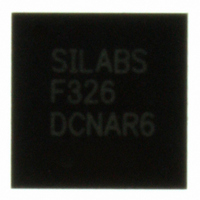C8051F326-GM Silicon Laboratories Inc, C8051F326-GM Datasheet - Page 49

C8051F326-GM
Manufacturer Part Number
C8051F326-GM
Description
IC 8051 MCU FLASH 16K 28QFN
Manufacturer
Silicon Laboratories Inc
Series
C8051F32xr
Specifications of C8051F326-GM
Program Memory Type
FLASH
Program Memory Size
16KB (16K x 8)
Package / Case
28-QFN
Core Processor
8051
Core Size
8-Bit
Speed
25MHz
Connectivity
UART/USART, USB
Peripherals
POR
Number Of I /o
15
Ram Size
1.5K x 8
Voltage - Supply (vcc/vdd)
2.7 V ~ 3.6 V
Oscillator Type
Internal
Operating Temperature
-40°C ~ 85°C
Processor Series
C8051F3x
Core
8051
Data Bus Width
8 bit
Data Ram Size
1.5 KB
Interface Type
UART/USB
Maximum Clock Frequency
25 MHz
Number Of Programmable I/os
15
Number Of Timers
2
Operating Supply Voltage
2.7 V to 3.6 V
Maximum Operating Temperature
+ 85 C
Mounting Style
SMD/SMT
3rd Party Development Tools
PK51, CA51, A51, ULINK2
Development Tools By Supplier
C8051F320DK
Minimum Operating Temperature
- 40 C
No. Of I/o's
15
Ram Memory Size
1280Byte
Cpu Speed
25MHz
No. Of Timers
2
Digital Ic Case Style
QFN
Supply Voltage
RoHS Compliant
Package
28QFN EP
Device Core
8051
Family Name
C8051F326
Maximum Speed
25 MHz
Lead Free Status / RoHS Status
Lead free / RoHS Compliant
For Use With
770-1006 - ISP 4PORT FOR SILABS C8051F MCU336-1450 - ADAPTER PROGRAM TOOLSTICK F326336-1306 - KIT DEV FOR C8051F326/7
Eeprom Size
-
Data Converters
-
Lead Free Status / Rohs Status
Lead free / RoHS Compliant
Other names
336-1296-5
Available stocks
Company
Part Number
Manufacturer
Quantity
Price
Company:
Part Number:
C8051F326-GM
Manufacturer:
SiliconL
Quantity:
811
Part Number:
C8051F326-GMR
Manufacturer:
SILICON LABS/芯科
Quantity:
20 000
6.3.2. External Interrupts
The /INT0 external interrupt source can be configured as edge or level sensitive. The IT0 bit (TCON.0, see
Figure 14.1 on Page 128) selects level or edge sensitivity. When global port I/O inputs are enabled, /INT0
will monitor the voltage at the input pin. The CPU will vector to the /INT0 interrupt service routine whenever
the pin detects the condition the external interrupt has been configured to monitor. TMOD.3 (GATE0) con-
trols the functionality of /INT0 as is shown in Table 6.4.
The /INT1 interrupt source provides an interrupt on two events, based on the logic level of GATE1
(TMOD.7). If GATE1 is set to logic 1, an interrupt is generated every two Low Frequency Internal Oscillator
clock cycles. This allows the CPU to vector to the /INT1 interrupt service routine at a rate of 40 kHz. If
GATE1 is set to logic 0, an interrupt is generated when the internal oscillator resumes from a suspended
state.
The pending flags for the /INT0 and /INT1 interrupts are set upon reset. If the /INT0 or /INT1 interrupt is
used, the respective flag should be cleared before enabling the interrupts to prevent an accidental inter-
rupt. The pending flags are for the /INT0 and /INT1 interrupt are in the TCON register.
6.3.3. Interrupt Priorities
Each interrupt source can be individually programmed to one of two priority levels: low or high. A low prior-
ity interrupt service routine can be preempted by a high priority interrupt. A high priority interrupt cannot be
preempted. Each interrupt has an associated interrupt priority bit in an SFR (IP or EIP2) used to configure
its priority level. Low priority is the default. If two interrupts are recognized simultaneously, the interrupt with
the higher priority is serviced first. If both interrupts have the same priority level, a fixed priority order is
used to arbitrate, given in Table 6.5.
6.3.4. Interrupt Latency
Interrupt response time depends on the state of the CPU when the interrupt occurs. Pending interrupts are
sampled and priority decoded each system clock cycle. Therefore, the fastest possible response time is 5
system clock cycles: 1 clock cycle to detect the interrupt and 4 clock cycles to complete the LCALL to the
ISR. If an interrupt is pending when a RETI is executed, a single instruction is executed before an LCALL
is made to service the pending interrupt. Therefore, the maximum response time for an interrupt (when no
other interrupt is currently being serviced or the new interrupt is of greater priority) occurs when the CPU is
performing an RETI instruction followed by a DIV as the next instruction. In this case, the response time is
18 system clock cycles: 1 clock cycle to detect the interrupt, 5 clock cycles to execute the RETI, 8 clock
cycles to complete the DIV instruction and 4 clock cycles to execute the LCALL to the ISR. If the CPU is
executing an ISR for an interrupt with equal or higher priority, the new interrupt will not be serviced until the
current ISR completes, including the RETI and following instruction.
The CPU is stalled during Flash write/erase operations. Interrupt service latency will be increased for inter-
rupts occurring while the CPU is stalled. The latency for these situations will be determined by the standard
interrupt service procedure (as described above) and the amount of time the CPU is stalled.
/INT0 Pinout
Edge Sensitivity
Level Sensitivity
Table 6.4. TMOD.3 Control of /INT0
Rev. 1.1
TMOD.3 = 0
P0.0
Rising Edge
Active High
TMOD.3 = 1
P0.2
Falling Edge
Active Low
C8051F326/7
49











